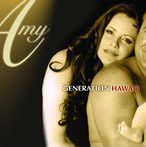AMY HANAIALII – GENERATION HAWAI’I
At a promotional performance held at Borders Books in February, I spoke with Amy about the influence of her tutu (grandmother) and its impact on Generation Hawaii. Jenny Napua Hanaiali’i Woodd was one of the original Royal Hawaiian Girls who, during the 1930’s and 40’s, showcased Hawaiian music and dance to visiting Americans. She went on to become the premier choreographer of Hawaiian numbers in Hollywood films with 22 halau (hula instruction) studios around Los Angeles, one across from the Chinese theater.
“My grandmother was a kumu hula (hula master teacher) for 70 years.” said Amy. “She taught Shirley Temple. She taught Sonja Henie how to hula on ice skates. She was up in Hollywood when everybody wanted to be Hawaiian. She choreographed a lot of shows in Vegas…She would just go in and make it as authentic as she could.”
Although Amy took voice lessons in the European classical tradition, it was Tutu Napua who arranged for her to receive instruction in traditional Hawaiian ha’i falsetto singing from the legendary Aunty Genoa Keawe. (Note that in Hawaiian culture, the terms Aunty and Uncle are used to affectionately honor elders in a community.) And it was Tutu Napua who inspired Amy to devote her vocal gifts mainly to traditional Hawaiian music.
Generation Hawaii offers a luscious selection of Hawaiian mele (songs), filled with opportunities for Amy to shine as a vocalist, in many cases as a lyricist, and occasionally as a composer. Anahaki, cut four, for which she contributed both lyrics and music, depicts the love making of the ‘iwa birds near the tide pool of Anahaki by the cliffs of the island of Moloka’i. Uluhua Wale Aa, the seventh cut, is a mele that Tutu Napua sang to Amy at home in Maui under the plumeria tree where they played music together. It is filled with dramatic contrasts of nature – the fragrant upland, a mountain rising from the sea, sudden showers sweeping across the hillside, and two great peaks covered by mist and floating cloud. Those initiated into the tradition of Hawaiian mele listen for the kaona or hidden meaning. Beneath the sensory images are messages of familial tenderness or passionate love, stories of unrequited yearning, and tributes to specific individuals, to name a few familiar themes.
Tributes abound in Generation Hawaii. Ho’oheno A‘o Pi’ilani, cut nine, honors the beloved ha’i singer Aunty Agnes Wood, represented in the song by the sweet rose lei of Pi’ilani. A song honoring King David Kalakaua, who restored hula to prominence in the late 19th century after decades of suppression, compares him to a flower that “wilts not in the sun” and is adorned with feathers of the mamo bird, the rare feathers used to make the capes worn by Hawaiian monarchs. The mele is a double tribute since Amy deliberately sings the version of this song performed by legendary singer Aunty Leina’ala Haili, honoring yet another Aunty.
Two songs on the album are in quite a different vein. We are richer for their inclusion since they deepen our understanding of Amy Napua Hanaiali’i’s artistic and personal path. No Na Hulu Kupuna, cut five, has a stately, dignified beat and chord progressions that suggest a procession or hymn. The kupuna are the elders in Hawaiian communities. With respect and reverence, Amy appeals to them for guidance and help in the face of the threats to her beloved Hawaii, threats that showed themselves in a frightening dream. She told me, “Hawai’i is struggling right now. A lot of people are moving there. A lot of building is going on. That dream came to me – losing everything in Hawai’i – our land, our language, our music. Just having it be more like here (LA). It just scared me and I woke up and I wrote all those lyrics down immediately and came up with that song.”
The final cut, In Hilo Town, shows another side of Amy’s musical heritage – jazz. Her lyrics paint a steamy picture of the town on the east side of Big Island. Combined with the languorous pace, the bluesy mood of the music and Amy’s surprising flair for the jazz idiom, the composition is enthralling. But after all the tradition-based songs on Generation Hawaii, you may wonder, “Where did that come from?”
Amy explained, “My grandmother was married five times and they were all musicians. When my grandmother was at the Lexington Hotel in New York, she met my grandfather who played first trumpet with Sammy Kaye, so I’ve always had that jazz big-band thing with me. And that’s really a tribute to my grandfather who played that style of music. In fact, this October I’m releasing an album with an orchestra of that type of music.” I’m eager to hear it. Grammy-nominated Generation Hawaii, which deserved to win the Grammy award, is a tough act to follow.













